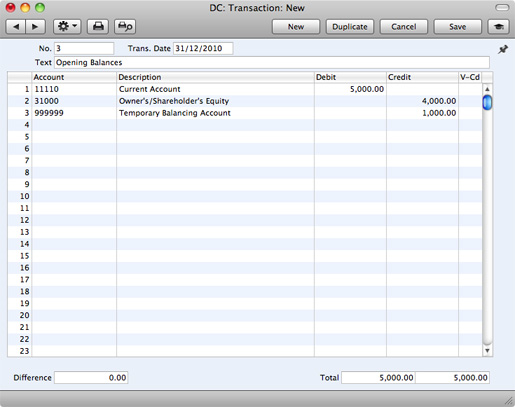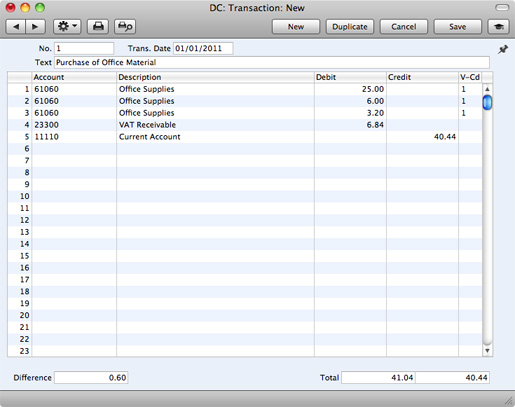Opening Balances in the Nominal Ledger
In the Nominal Ledger, the task of entering opening balances can have two stages:
- You should enter balances for each Account as they stood at the end of the previous fiscal year. Use the Transaction register for this task. This information should be available in the Trial Balance report obtained from your old system.
You can enter a single opening balance figure for each Account, or you can divide the opening balance figure into individual postings. This decision may depend on the Account itself.
- If appropriate, enter the Transactions for the current year to date, again using the Transaction register.
Once you have entered all balances and Transactions, print out a Trial Balance and compare it with that obtained from your old system. Any discrepancies should be investigated immediately: any delay will make this more difficult.
The following sections assume you have already defined a Chart of Accounts and a set of VAT Codes.
To enter Account balances as they stood at the end of the previous fiscal year to the Nominal Ledger using the Transaction register, follow these steps:
- Select the Nominal Ledger module using the [Module] button in the Master Control panel or the ⌘-0 keyboard shortcut.
- Click the [Transactions] button in the Master Control panel to open the Transaction register.
- When the 'Transactions: Browse' window opens, click [New] on the Button Bar to open a new record.
- Enter the information as shown in the following illustration. Full details about the fields are to be found in the description of the Transaction register. It is recommended that you choose a Transaction Date that is at the end of the previous fiscal year and that is, in any case, prior to the date when you will be starting work with Standard Accounts.

If you are entering a single opening balance figure for each Account, use each row in the grid to enter these balances, taking the figures from the Trial Balance report produced by your old system. If you are entering opening balances as individual postings, enter each posting on a separate row. You can enter single opening balance figures for some Accounts, and individual postings for others. For example, you can enter previously unreconciled postings to your Bank Account(s) individually, so that you can reconcile them with your bank statement later. Please refer to the description of the Account Reconciliation registerfor details about reconciling postings with your bank statement.
- The Transaction screen has 300 rows, allowing you to enter opening balances for up to 300 Accounts in a single record. If you need to enter a significant number of opening balances, you may want to do so using a number of Transaction records. This may be because 300 rows is not sufficient, or it may be because you may want to save your work periodically, by clicking the [Save] button in the top right-hand corner.
When you save a Transaction, Account Balances will be updated immediately. Therefore, you will not be able to change a saved Transaction, hence the need to create a new record after saving.
A Transaction record has to balance for you to save it, so each time you need to save, you can make a balancing posting to a temporary balancing Account as shown in the illustration above.
If you discover a mistake at a later date, you will be able to correct the record using one of the correction features.
- Finish with [Save] when you have entered the last balance, and close the window by clicking the close box. Immediately on saving, the Transaction will update the balances of each Account.
If you are starting to use Standard Accounts in the middle of a fiscal year, you should now enter the Transactions for the current year so far. You should enter these from the original documentation, not copy them from Transaction Journal reports produced from your old system. This will ensure that you do not enter any Transactions that relate to your Sales or Purchase Ledgers. These will be entered later. Follow these steps:
- Using the [Module] button in the Master Control panel, ensure you are still in the Nominal Ledger.
- Click the [Transactions] button in the Master Control panel to open the Transaction register.
- When the 'Transactions: Browse' window opens, click [New] in the Button Bar to open a new record.
- Enter the information as shown in the following illustration. Full details about the fields are to be found in the description of the Transaction register. Ensure you use the same Transaction Date that was used when entering the Transaction to your previous system.

- The Transaction screen does not have an OK check box, so Account Balances are updated as soon as you save the Transaction. Therefore, before saving the Transaction, make sure that no mistakes have been made. One check is that the Debit and Credit totals are the same. Once you have saved the Transaction, you will not be able to change it.
- Click the [Save] button (or use the Shift-Enter keyboard shortcut) to save the Transaction. Alternatively, if you click the [New] button (or use the ⌘-N keyboard shortcut), the Transaction will be saved and closed, and a new empty record will be opened, allowing you to enter another Transaction.
You can use another feature when you need to enter several Transactions quickly in one sitting and don't want to interrupt your typing by reaching for the mouse. Enter the debits in a Transaction first and then, with the cursor in the Credit field in the final credit row, press the Return or Enter key twice. The first pressing causes the correct credit amount to be entered for you, balancing the entry. The second saves, closes and commits the Transaction to the Nominal Ledger and opens a new, empty, Transaction.
- Finish with [Save] when you have entered the last Transaction, and close the window by clicking the close box.
---
In this chapter:
Go back to:
